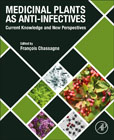
Medicinal Plants as Anti-infectives: Current Knowledge and New Perspectives
Chassagneux, Jean-François
Medicinal Plants as Anti-infectives: Current Knowledge and New Perspectives provides comprehensive and updated data on medicinal plants and plant-derived compounds used as antimicrobials in a range of locations (such as the Balkans, Colombia, India, Lebanon, Mali, Pakistan, Southeast Asia, South Africa, and West Africa). It also provides an overview on the most recent innovations and regulations in the field of drug discovery from ethnobotanical sources. This book will help readers to better appreciate the role of plants and phytomedicines as anti-infectives, to better assess the health benefits of plant-derived products, to help implement new methodologies for studying medicinal plants, and to guide future researchers in the field. Medicinal Plants as Anti-infectives: Current Knowledge and New Perspectives is a valuable resource for students, academic scientists, and researchers from the fields of ethnobotany, pharmacy, medicinal chemistry, and microbiology, as well as for professionals working in national or international health agencies, or in pharmaceutical industries. Provides an overview of new methods and tools developed in the field of drug discovery from ethnobotanical sources (e.g., DNA barcoding, metabolomics, quorum quenching) Contains real-world insights from experts in the field Presents specific research program results to inspire further research in additional regions INDICE: 1. A review of medicinal plants used as antimicrobials in Colombia2. Plants used in Lebanon and the Middle East as antimicrobials3. Medicinal plants in the Balkans with antimicrobial properties4. Medicinal plants used in South Africa as antibacterial agents for wound healing5. The use of South African medicinal plants in the pursuit to treat gonorrhea and other sexually transmitted diseases6. A selection of antibacterial medicinal plants from Pakistan7. Medicinal plants used as anti-diarrheal agents in the lower Mekong basin8. Medicinal plants from West Africa used as antimalarial agents: an overview9. Mycobacterium quorum quenching and biofilm inhibition potential of medicinal plants10. Untargeted metabolomics for the study of anti-infective plants11. Value chains and DNA barcoding for the identification of anti-infective medicinal plants12. Fungal endophytes: a source of antibacterial and antiparasitic compounds13. Antiviral potential of medicinal plants: a case-study with guava tree against dengue virus using a metabolomic approach14. How History Can Help Present Research of New Antimicrobial Strategies: The Case of Cutaneous Infections Remedies Containing Metals From The Middle Age Arabic Pharmacopeia15. Improved traditional medicine for infectious disorders in Mali16. Selecting the most promising local treatments. Retrospective treatment outcome surveys and reverse pharmacology17. Nagoya Protocols and ABS: basic concepts
- ISBN: 9780323909990
- Editorial: Academic Press
- Encuadernacion: Rústica
- Páginas: 586
- Fecha Publicación: 10/04/2022
- Nº Volúmenes: 1
- Idioma: Inglés
